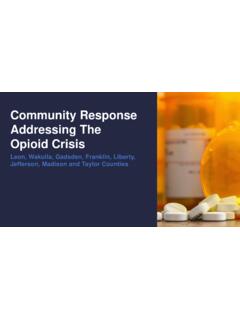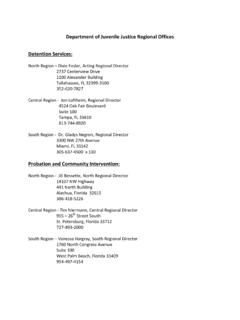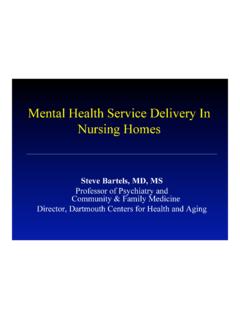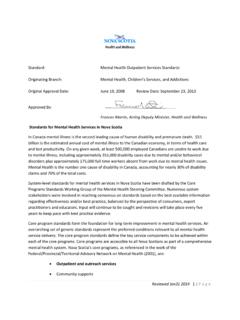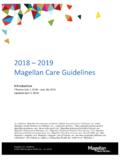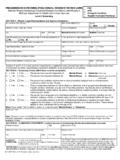Transcription of Mental Health and Academic Achievement in Youth
1 Youth Mental Health and Academic Achievement Americans are inundated with messages about success in school, in a profession, in parenting, in relationships without appreciating that successful performance rests on a foundation of Mental Health .. - Department of Health and Human Services, 1999. For adolescents, ages 13 to 18, the lifetime prevalence of Mental disorders severe enough to cause significant impairment in daily functioning is approximately 20%.1 The average size of a secondary school class in the United States is approximately 23 students,2 meaning there may be four or five adolescents in every classroom who are struggling with serious Mental illness.
2 Yet, nearly two-thirds of these adolescents do not receive Mental Health This is particularly troubling because Mental illness does not affect emotional Health in isolation; it is known to influence and co-occur with problems in many domains of students' lives, including their social interactions and educational In order to promote the best possible outcomes for students, there is a great need for early identification and treatment of Mental Health disorders. School difficulties may be a sign of emerging or Secondary school students who suffer from unrecognized Mental illness Mental illness are more likely to earn failing Poor attendance, particularly frequent absences grades across all subjects and are retained at for vague, non-specific physical Health problems, grade level more often than Youth with may be related to underlying Mental Health disabilities as a Difficulties with Academic work,4,5 social Graduation and Higher Education integration, adjustment to school, behavior 2005 National Comorbidity Survey Replication regulation, attention.
3 And concentration may be data indicated that the proportion of school school-related signs of emerging or existing Mental terminations attributable to Mental disorders was Health problems in largest for high school graduation ( percent). but also meaningful for primary school graduation The impact of Mental illness on school success ( percent), college entry ( percent) and and Academic Achievement college graduation ( percent).10. Attendance Only 32 percent of students with a serious Mental High school students who screen positive for illness continue onto postsecondary psychosocial dysfunction have three times the absentee and tardy rates of students not identified Having two or more co-morbid disorders is with psychosocial significantly associated with termination of schooling prior to high school Perceived Competence Students reporting high levels of psychosocial A Department of Education survey has stress are more likely to perceive themselves as demonstrated that depression and other less academically emotional
4 Disturbances are the leading cause of disability-related high school Concentration Students with greater depression symptoms are Disorders associated with Academic difficulty more likely to report difficulty concentrating in class Students with emotional and behavioral disorders and completing who exhibit externalizing problem behaviors ( Academic Achievement and Grade Completion attention and conduct disorders) are more likely to experience Academic deficits and terminate In a 2004 study, approximately 83 percent of schooling than students who evidence internalizing students with emotional and behavioral disorders ( mood and anxiety disorders) ,10.
5 Scored below the mean of the control group in reading, writing, and Anxiety steeper increase in GPA over five semesters than Anxiety disorders, which affect percent of all non-users and medical SBHC adolescents1 and co-occur in approximately one Social and emotional learning programming in third of depressed Youth ,13 are associated with a schools has been found to improve students'. reduced likelihood of attending Achievement test scores by 11 to 17 percentile People with a lifetime occurrence of social phobia are almost twice as likely to fail a grade or not finish High school SBHC users in one study had a 50.
6 High school as those who have never had the percent decrease in absenteeism and 25 percent decrease in tardiness two months after receiving Depression school-based Mental Health services and High depression scores have been associated with low Academic Achievement ; high scholastic Several studies have shown that students who anxiety;16 increased school suspensions;17 and used SBHCs were twice as likely to stay in school decreased ability or desire to complete homework, as students who did not use SBHC concentrate, and attend 1. Merikangas, K. R. et al. (2010). Lifetime prevalence of Mental disorders in Suicidality adolescents: Results from the National Comorbidity Study-Adolescent Supplement Adolescents who have attempted suicide in the (NCS-A).
7 Journal of the American Academy of Child and Adolescent Psychiatry 49(10):980-9. previous twelve months show significantly lower 2. Organization for Economic Cooperation and Development. (2010). Education at a Glance 2010: OECD Indicators. levels of school performance and school 3. DeSocio, J. and Hootman, J. (2004). Children's Mental Health and school success. The connectedness than Journal of School Nursing 20(4):189-196. 4. Blum, R. et al. (2000). Protecting Teens: Beyond Race, Income, and Family Structure. Students who perceive their Academic Minneapolis, MN: University of Minnesota Center for Adolescent Health .
8 5. Masi, G. et al. (2001). Depressive symptoms and Academic self-image in adolescence. performance as failing' are three times more likely Psychopathology 34:57-61. 6. Gall, G. et al. (2000). Utility of psychosocial screening at a school-based Health to report suicidal thoughts and ten times as likely to center. The Journal of School Health 70(7):292-298. report suicide attempts than students who feel their 7. Humensky, J. et al. (2010). Adolescents with depressive symptoms and their performance is challenges with learning in school. The Journal of School Nursing 26(5):377-392. 8. Nelson, R. et al. (2004).
9 Academic Achievement of K-12 students with emotional and behavioral disorders. Exceptional Children 71(1):59-73. Substance Use Disorders 9. Wagner, M. and Cameto, R. (2004). The Characteristics, Experiences, and Outcomes of Youth with Emotional Disturbances. A Report from the National Longitudinal Substance abuse, including alcohol abuse in Transition Study-2 3(2):1-7. 10. isolation, is significantly associated with termination Breslau, J. et al. (2008). Mental disorders and subsequent educational attainment in a US national sample. Journal of Psychiatric Research 42(9):708-716. of primary and secondary school, failure to enter 11.
10 United States Government Accountability Office. (June 2008). Young Adults with college, and termination of Serious Mental Illness; Report to Congressional Requesters GAO Report Number GAO-08-678. Washington, 12. Planty, M. et al. (2008). The Condition of Education 2008 (NCES 2008-031). Attention Disorders National Center for Education Statistics, Institute of Education Services, Attention problems are the principal predictor of Department of Education. Washington, DC. 13. Kovacs, M. (1996). Presentation and course of major depressive disorder during diminished Achievement relative to expectations on childhood and later years of the life span.
